by Editor | Mar 28, 2011 | Food
By Elena del Valle
Photos by Gary Cox
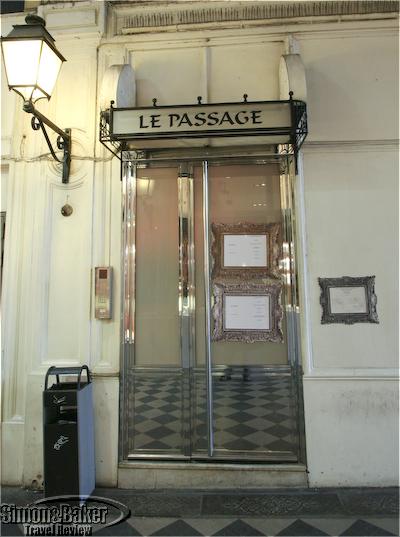
For years we dined at Lucas Carton, a well known gourmet restaurant, whenever we visited Paris, France. Then one year Alain Senderens, the chef and restaurant owner, converted the restaurant into a bistro; modernized the look and style, changed the menu and reopened under his name, Senderens. We had dined several times at Senderens when we heard that there was a new bar area upstairs that served a limited menu including a set lunch menu.
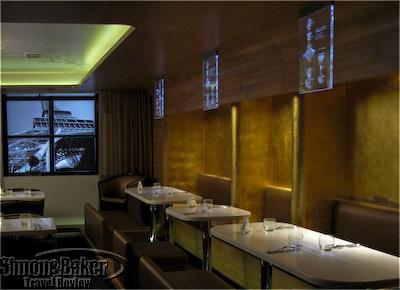
The main seating area at Bar Le Passage
Twice during a recent winter visit to Paris we had an opportunity to sample the food options at Bar Le Passage. The first time we requested a table upstairs at Bar Le Passage one day in advance. Because the few tables were already reserved we accepted two seats at the bar. Although the bar stools were rather uncomfortable, the room was pleasant, furnished simply with elegant touches, the bar tender was service oriented and spoke some English and, most importantly, our lunch was delicious.
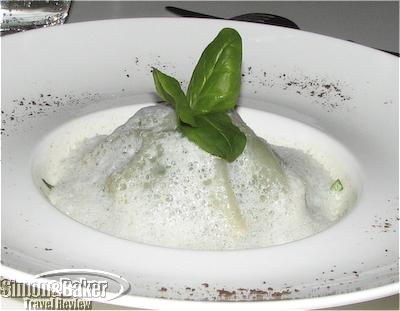
The vanilla lobster
We began with a glass of non vintage Pommery Champagne then ordered one three course set menu (35 euros) which that day was a cold Game Pie, Codfish a La Plancha, and an ice cream and fruit combo as well as a Vanilla lobster (25 euros). An amouse bouche arrived before our order and there was also a plate of bread. For dessert, we recognized and old favorite from the days of Lucas Carton, the Samana chocolate plate (half a portion) with candied cherries (10 euros).
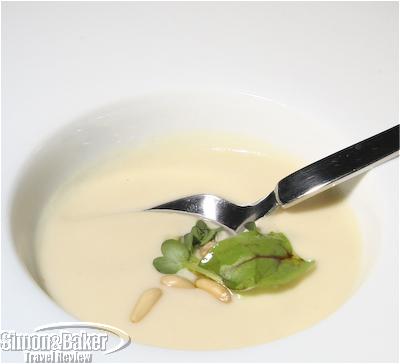
The amouse bouche was soup garnished with pine nuts and herbs
The next time we reserved a table at Bar Le Passage several days in advance. We were running a few minutes late and I called to make sure they would hold our table but I was on hold so long the answering system cut the call. Although we arrived a few minutes late our reservation was still valid. We had two tables to choose from and picked one of the two tables next to the bar itself. We could have chosen to sit at a table in the center of the main seating area of the bar as well.
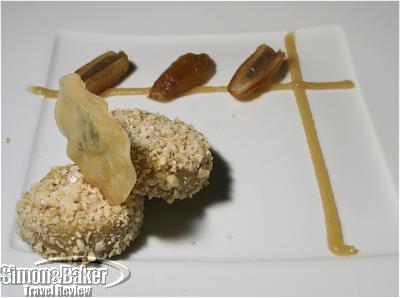
Pistachio encrusted foie gras
This time we tried the foie gras which was pistachio encrusted and served with stuffed dried figs and a lemon sauce. Once again we ordered the Vanilla lobster and Samaná dessert.
Both meals were tasty and satisfying. The service was attentive and the setting was attractive. We will keep Bar Le Passage at Senderens on our list of options for a quick gourmet bite in the City of Lights, especially if we are in the Place de la Madeleine and its environs. Bar Le Passage, 9, Place de la Madeleine, 75009, telephone +33 1 42 65 56 66, fax +33 1 42 65 06 23, email restaurant@senderens.fr.

Samaná with candied cherries
by Editor | Mar 21, 2011 | Luxury Travel
Article and photos by Josette King
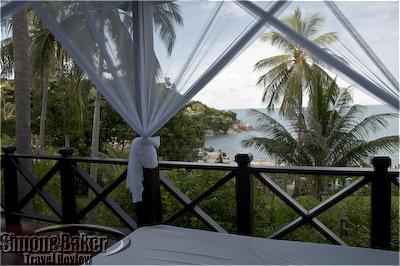
The terrace overlooked the gardens and the beach
The late Akorn Hoontrakul, one of Thailand’s prominent hospitality executives, first caught sight of The Tongsai Bay from the sea in 1985 and by his own admission immediately fell in love with it. Koh Samui (or simply Samui, as the locals call it) was still an isolated island community off the east coast of Thailand then. Its economy was based on subsistence agriculture and fishing, with coconut as the main cash crop. Tourism accommodations were limited to clusters of beach shacks for the adventurous back-packers that were beginning to spread through the region.
Soon, Akorn had purchased the land and set out to turn The Tongsai Bay into the first five-star resort on Samui. A dedicated nature lover, he personally oversaw the planning of the property to ensure that it would respect the natural beauty of the site. The Tongsai Bay opened its doors in 1987 and remains to this day the secluded luxury retreat spread throughout a lush amphitheater-like hillside overlooking the waters of the Gulf of Thailand envisioned by its founder.
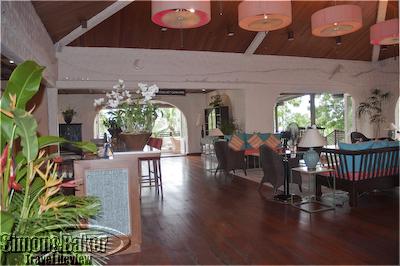
Lounge at Tongsai Bay
Samui as a whole, however, has not fared so well. With its tourism industry booming over the past decade, the island is now home to 55,000 inhabitants, and its tourist population can peak to well over 150,000 at the height of the season. Accommodation alternatives from upscale beach resorts to inland budget hotels along with eateries, shopping malls and support industries have grown exponentially. All of which has grievously strained the fragile ecosystem of this once remote 88 square mile (235 square kilometer) tropical island. But building on the environmental legacy of Akorn Hoontrakul, his son Thanakorn, and daughter in law Saisiri, the current owners of The Tongsai Bay, implemented the staunch conservation practices required to address 21st century ecological challenges.

Environmental expert Jultamart Tongphauk outlines the Green Project
As early as 2003, they initiated the Green Project for their property. This was a far-reaching approach to the main environmental issues of the island: waste management, chemical use minimization, flora and fauna conservation and energy saving. Comprehensive policies and procedures were elaborated and strictly enforced at The Tongsai Bay, complemented by an extensive education program to build environmental conscience among the staff. Under the leadership of Jultamart Tongphauk, an environmental expert who holds a degree in environmental engineering from Khon Kaen University in northern Thailand, the project’s mission is to preserve the balance among humans, animals, trees and the environment on the property and within the community at large. Community service participation is one of the tenets of the Green Project.
The Tongsai Bay owners have contributed by donating to the island conservation land originally acquired by Akorn. Other activities range from supporting green education within the island’s public schools to reforestation of its wooded and mangrove areas. The Tongsai Bay also supports various local, national and international wildlife protection organizations.
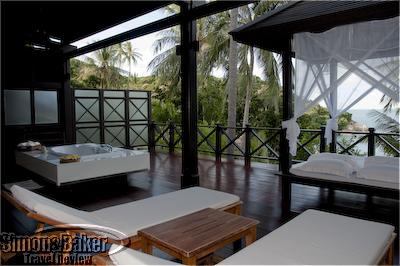
My villa featured a vast terrace for outdoor living
Closer to home, in addition common conservation practices such as reducing the use of plastics and other disposable items, implementing usage of energy and water saving devices, and treating used waters for irrigation purposes, The Tongsai Bay is engaged in one of the most comprehensive recycling efforts I have come across anywhere. I was fortunate to have Jultamart (Jul for short) as my guide for a visit of the recycling center located in a wooded area a bumpy 15 minute drive from the property. With Jul, one of her assistants and a squadron of voracious mosquitoes, I spent a fascinating morning touring an impressively low-tech but very efficient facility that opened my eyes to the near-endless opportunities to repurpose household waste. I followed the journey of the meticulously sorted garbage (eight categories in all, in color-coded, and recycled, bags and bins) far beyond the usual trip to the local pig farm and commercial recycling plant, although some did go there.
Most fascinating to me was the Fertilizer House where vegetable waste was not only composted but transformed into natural fertilizer to be used in all the gardens of the property, including the organic herb and flower gardens that supplied the kitchens and the housekeeping department respectively. This was also where the orchids and other tropical blooming plants that graced the guest accommodations were sent to recover after they had passed their prime.
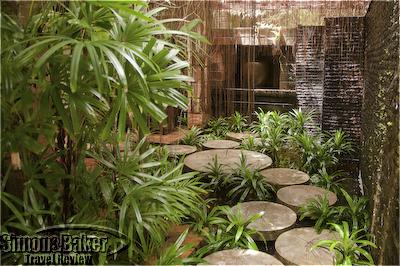
Prana Spa entryway
Other vegetable waste such as citrus peels was being brewed into various pesticide and house-cleaning concoctions. The look and smell of the substances in the vats were sometimes dubious but the outcome was highly effective, judging by the absence of bugs and the lush state of the gardens around the resort, where the use of chemicals was prohibited. Overall, the proven value of the Green Project has made it a blueprint for new properties that also understand the importance of preserving the island’s rich natural heritage for future generations.
I thoroughly enjoyed The Tongsai Bay, and my superbly appointed suite secluded in gorgeous natural surroundings; all the more so for knowing that I could be free of the nagging environmental concerns I sometimes feel in luxury resorts. Visit the Simon & Baker Travel Review to read more about my stay at the Tongsai Bay, Koh Samui in Thailand.
by Editor | Mar 14, 2011 | Luxury Travel
By Elena del Valle
Photos by Gary Cox
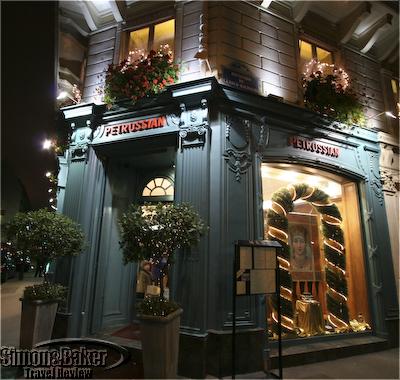
The Petrossian storefront in the early evening
For years we have enjoyed varied French cuisine styles at restaurants in Paris, France from humble bistros in hidden corners to the famed temples of haute cuisine in the best neighborhoods. On a recent visit we thought it would be fun to sample another type of cuisine.
With this goal in mind we headed to Le 144 Petrossian Restaurant known for its Russian dishes prepared by an up-and-coming young chef of Senegalese heritage. It was snowing when we arrived in the quiet Seventh Arrondisement restaurant. After handing our coats to the young lady at reception we headed upstairs, past the bar to a corner table. After perusing the menu and asking several questions of Jean Baptiste, our waiter, we settled on the house specialty, the Hommage a la Gastronomie Russe Petrossian Menu avec caviar Ossetra Tradition (served to a minimum of two people and the entire table) which consisted of 10 small savory and sweet dishes and a portion of Petrossian Ossetra Caviar served in its can and cost 130 euros per person.
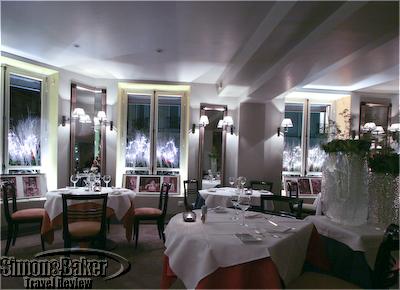
Le 144 Petrossian dining room with holiday lighting in the windows
While our meal arrived we kept our appetite at bay with salmon bites, pastries filled with goat cheese and meat and a glass of rose champagne. Although we were temped to have vodka we opted for a bottle of non vintage Bollinger Champagne instead to accompany our dinner.
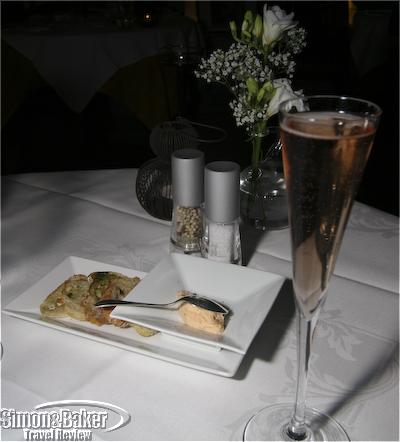
Tasty bites and Champagne to whet the appetite
By the time dinner arrived we were ready to eat. First, there was Soupe de poisson impériale, a “milky” fish soup. It was followed by Zakouskiks: Huit petits plats issus de la tradition, an ample selection of appetizers served at the same time: eggplant “caviar,” delicious smoked salmon, Russian salad with crab, herring, a sardine like fish, king crab, and melt-in-your-mouth salmon eggs. Although we liked all the dishes the salmon, eggplant and Ossetra caviar were our favorites by far.
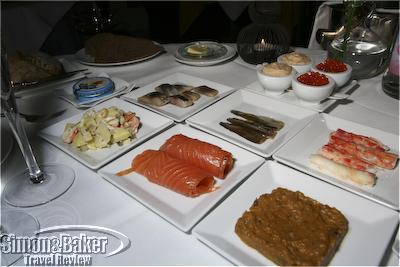
The cold dish selection in the Russian menu
By then we were ready to call it a night only to remember there were four warm courses coming our way: Agneau Yagouline, Caucasian style lamb served with pomegranate and a spiced fruit compote; Esturgeon grille comme dans la Caspienne, grilled sturgeon with a cream mushroom sauce (a favorite); Kotlety de boef et agneau épicés, a spicy lamb in a citrus sauce; and Pelmenis, meat balls in a creamy anisette sauce (a favorite).
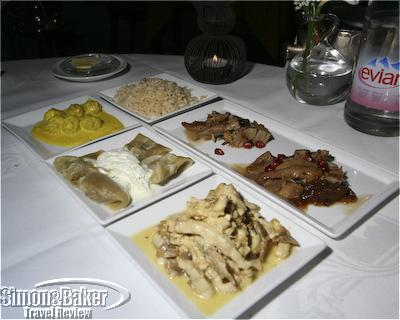
Russian menu warm dishes
Before dessert arrived we were able to briefly meet Chef Rougui Dia in the kitchen. Her gracious and shy demeanor was disarming. We look forward to sampling more of her dishes on another occasion.
Dessert was chilled and did not match the descriptions in the menu. We were served cheesecake; salt and caramel cake, a pear pistachio cherry topped cake; chilled pineapple coconut; and pear and citrus zest.
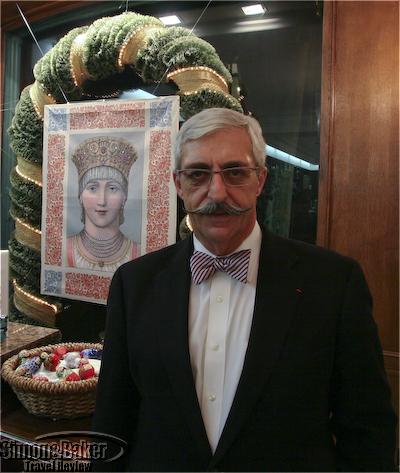
Armen Petrossian in front of the Paris boutique

Petrossian Ossetra Caviar
The following week, we visited the Petrossian shop located a few steps away from the entrance to the restaurant where it was possible to purchase some of the dinner specialties like caviar. While at the shop we met Armen Petrossian, the head of the company. In addition to Paris, the company, owned by the Petrossian Family, has boutiques with cafes in New York, Los Angeles and Las Vegas. Le 144 Petrossian Restaurant, 18 Boulevard de la Tour Maubourg, 75007, Paris, France, +33 1 44 11 32 32, www.petrossian.fr
by Editor | Mar 7, 2011 | Luxury Travel
Article and photos by Josette King
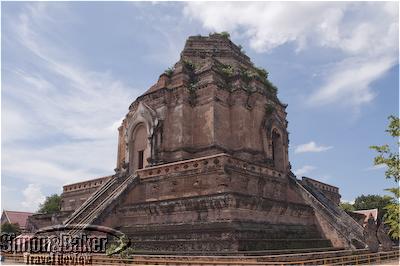
Chiang Mai’s Chedi Luang dates back to the 14th century
I landed in Chiang Mai on a sunny fall afternoon to a bird’s eye view of what makes this ancient northern city one of the most sought after tourist destinations in Thailand. In the center of a broad valley outlined by high verdant hills the skyline of the city was a mosaic of contemporary buildings tightly mingling with the distinctive scalloped roofs of Buddhist temples. At the heart of this panoramic vista, a mile square medieval moat outlined the historic core of what was once the capital of the Lanna Kingdom, an ancient state that spread from eastern Burma (also known as Myanmar) to the western valleys of Laos. Founded in 1296 A.D., Chiang Mai became an important cultural and religious center before successive military invasions set off its decline and ultimately caused its rulers to abandon the city in the 18th century.
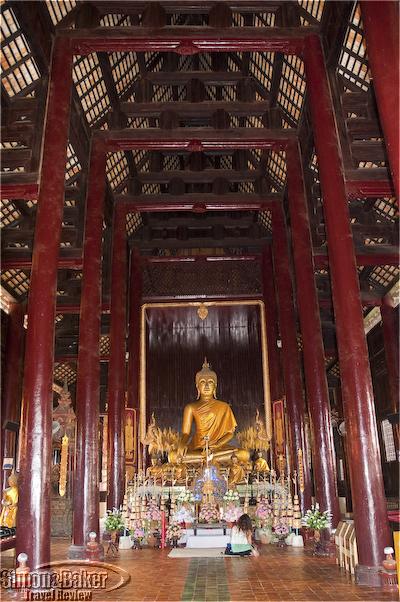
Wat Phan Tao is built of teak in the Lanna Thai style
Far away and hard to reach from Bangkok 430 miles (700 kilometers) to the south, Chiang Mai became a mostly ignored provincial town in the foothills of the Himalayan Mountains. This helped preserve its cultural legacy and laid back charm to be re-discovered by mid-20th century tourists. The city’s reputation as an exceptional destination to experience the traditional arts, crafts and culture of northern Thailand, as well as the unspoiled natural beauty of the surrounding hills, has grown exponentially over the past half century; and so has the city itself.
Tourism has become an important economic growth factor for Chiang Mai, which now welcomes over one million visitors annually. A vast array of hospitality options has developed around the city including two unique luxury boutique hotels that I especially enjoyed.
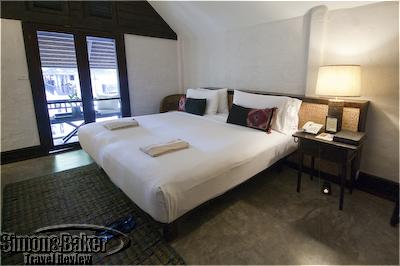
My room at the Tamarind Village had a traditional Lanna Thai flair
Tamarind Village was a charming contemporary version of a traditional mountain village, ideally located within the historic center. The intimate two-story property was laid out around a series of internal courtyards filled with fragrant tropical vegetation. Within the tranquil walled compound, every detail paid homage to the Lanna Thai cultural and artistic heritage. The entire property was decorated with the distinctive crafts of nearby hill tribes. At the restaurant, the menu highlighted traditional local cuisine and treatments at the intimate Village Spa focused on herbal products drawn from the Lanna tradition of natural healing. Even the gift boutique was brimming with ethnic jewelry, antique crafts and clothing made from tribal textiles. Guest accommodations were a harmonious balance of timeless serenity and contemporary comforts. And the thirty Buddhist temples that still remain within the square mile of the historic center, including some of the most revered ones in the city, were just a few minutes’ walk beyond the Village walls.
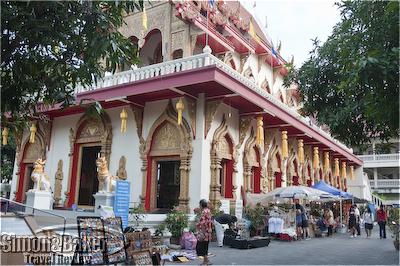
Sunday Market stalls settle in a temple courtyard
Then there was the Sunday Walking Market, a colorful Chiang Mai tradition that unfolds every Sunday evening right in front of Tamarind Village on Rajdamnoen Road. The street is blocked to traffic then. Local craftspeople set up small displays and sell their wares. This was the most enjoyable shopping experience of my entire visit to Thailand. I was impressed by the quality of the items, and loved their very reasonable price. This was also a time where temple courtyards filled up with food stalls; and with five temples along Rajdamnoen Road, there were plenty of opportunities to sample real Northern Thai food.
Tamarind Village offered a lovely opportunity to immerse myself into Chiang Mai’s past; the dusitD2 welcomed me onto its future.
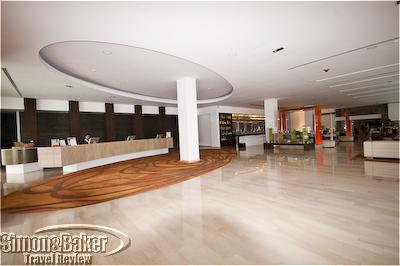
DusitD2 reception and bar
The D2, as it was affectionately called by the hip local community and visitors alike, was an ultra-modern property that combined the highest standards of contemporary hospitality with a striking avant-garde East Asian décor to create a chic urban sanctuary in the midst of the city’s bustling downtown. And just as hip as the guests were the charming, attentive staff that were not only able to meet and even anticipate my needs, but also could break into a choreographed line dance in the middle of superb minimalist lobby to mark the afternoon staff change! The restaurant, Moxie, was nationally acclaimed for its eclectic fusion of western and Asian haute cuisine. I also enjoyed its generous and equally imaginative breakfast buffet.
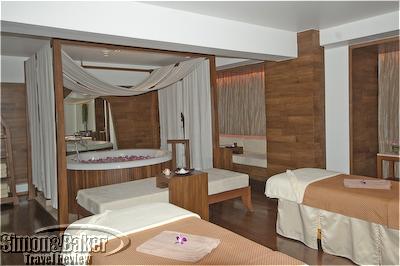
Devarana Spa treatment suite at DusitD2
The spa, Devarana (Sanskrit for Garden at Heaven’s Gate) lived up to its name with its serenely luxurious environment and its therapists trained to combine Thai massage with the best known international methods to create outstanding treatments. My spacious, light-filled suite was a clear testimonial to what made the dusitD2 a favorite with business travelers as well as tourists. The generous array of the latest amenities included a work-size desk with an ergonomic chair and reliable, high-speed WiFi connection secured with computer-generated user and pass codes. And a vibrant tourism experience was just outside my door. In addition to several Buddhist temples within minutes walk, the Vieng Ping Night Bazaar building was located just across the street from the hotel.
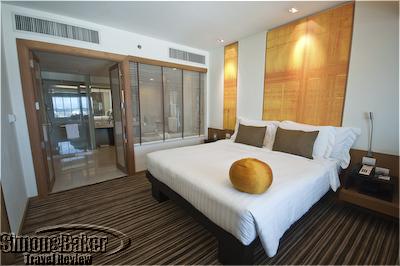
The bedroom had a serene contemporary decor at DusitD2
The vast three-story shopping arcade under a Thai temple-style roof was filled with shops and stalls bursting with crafts, clothing and antiques. In front of the arcade both sides of Chang Khlan Road was a gauntlet of street vendors selling souvenirs and mass-produced articles of all kinds. Open from late afternoon until late evening, the Night Bazaar was not just a place to shop but possibly also the most popular tourist attraction in Chiang Mai. There also was a huge food court in the Kalare Center across the street, with a large selection of international food stalls and an occasional performance by traditional Thai dancers and musicians.
Visit the Simon & Baker Travel Review to read more about my stay at the Tamarind Village and dusitD2 Chiang Mai in Thailand.
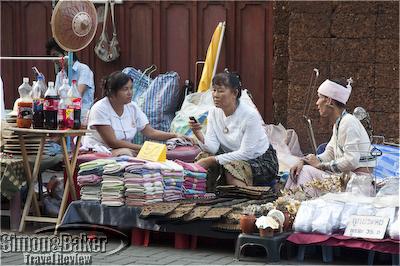
Market stall at Chiang Mai’s Sunday Market

































